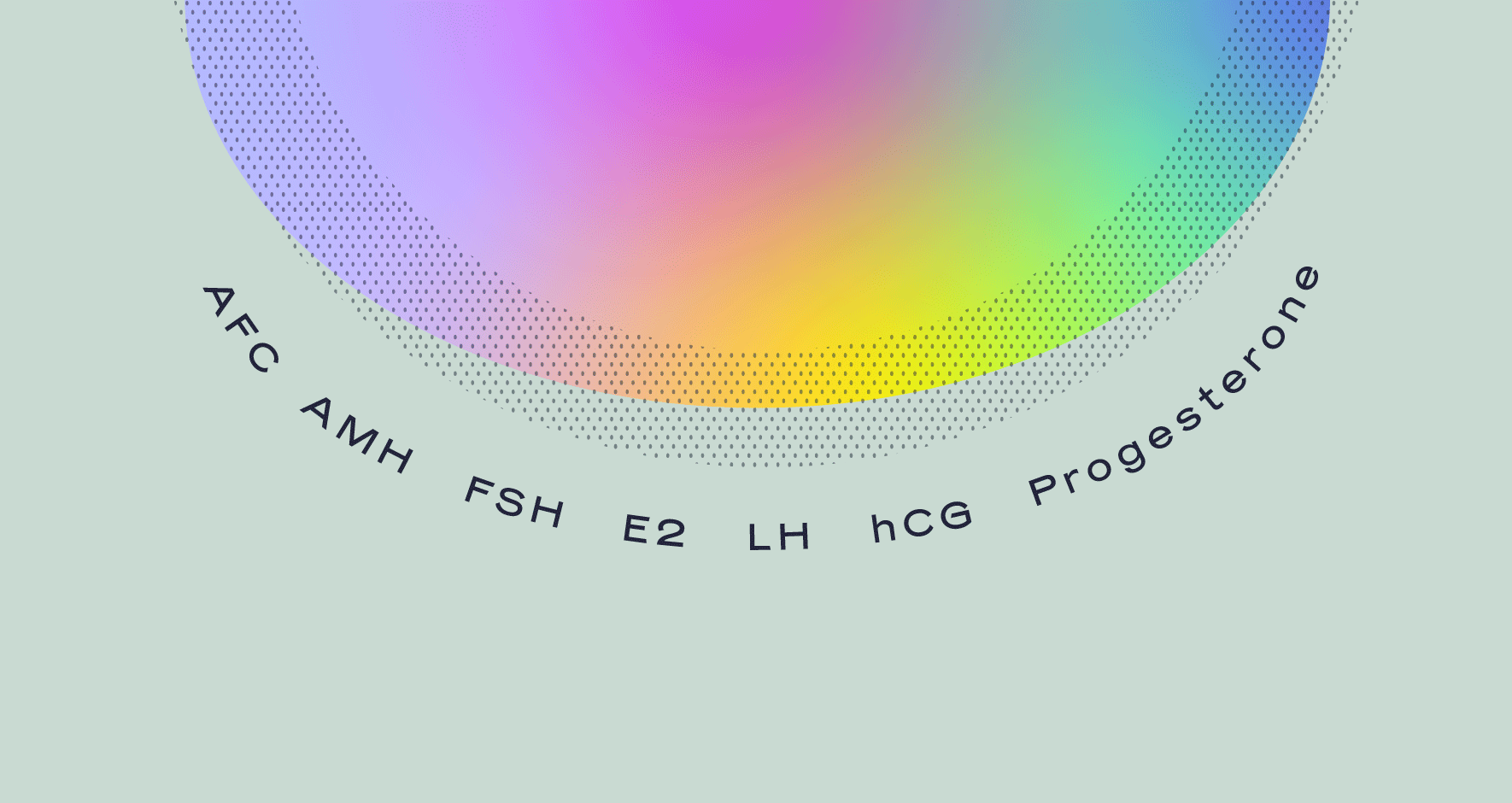Understanding Fertility Tests: Antral Follicle Count and Other Baseline Results

Medically reviewed by Linda Streety, RN, BSN
What are baseline tests for fertility and why do I need them?
A month before starting the ovarian stimulation part of in vitro fertilization (IVF) - the process of administering IVF medications to encourage more of your follicles to grow eggs to maturity while controlling ovulation - your reproductive endocrinologist (RE) will conduct “baseline fertility tests." These tests include bloodwork and a transvaginal ultrasound, and typically take place on day two or three of your menstrual cycle. The tests will give your RE a sense of your ovarian reserve (the remaining supply of eggs in your ovaries), pelvic health, and overall chance of success. Together, these help your RE determine if you need any treatment before beginning the IVF process, as well as decide on the medication protocol and starting dose for your ovarian stimulation.

6 Second Snapshot
-
Before starting ovarian stimulation, your clinic will conduct baseline fertility tests – including blood work and a transvaginal ultrasound – on day two or three of your menstrual cycle.
-
The blood tests may include tests for AMH, FSH, Estradiol, Progesterone, LH, and hCG.
-
The ultrasound will check for your overall pelvic health as well as your antral follicle count – how many visible follicles are present in your ovaries.
-
Together, the tests help your RE determine your ovarian response and decide on your stimulation protocol (the medications used to encourage more of your follicles to grow eggs to maturity while controlling ovulation).
What is Ovarian Reserve Testing?
Ovarian reserve testing is a combination of blood tests that check your fertility hormone levels and give your RE a sense of how many eggs remain in your ovaries (your ovarian reserve). If you decide to do IVF, your RE will use information from your baseline test results to create an ovarian stimulation protocol to try to optimize how many eggs they can retrieve, since each egg retrieved will improve your chance of success with IVF.
The tests your RE may order include:
-
Anti-Müllerian Hormone (AMH) - Levels of this hormone help your RE understand how many eggs are in your ovaries. High AMH corresponds with high ovarian reserve, and low AMH corresponds with low ovarian reserve.
-
Follicle-Stimulating Hormone (FSH) - This hormone is released by the pituitary gland in the brain, and helps to regulate your menstrual cycle, including the release of eggs from the ovaries.
-
Estradiol (E2) - This estrogen is secreted by follicles in the ovaries. On day three of your menstrual cycle – when your RE will likely order tests – high E2 levels may help your physician understand if your FSH is accurately predicting your ovarian response. High E2 levels may indicate a benign ovarian cyst or PCOS.
-
Progesterone - Levels of progesterone rise after ovulation to prepare the body for implantation. Levels that are too low or too high can help your RE understand why you are experiencing infertility.
-
Luteinizing Hormone (LH) - This hormone is also released by the pituitary gland and helps to regulate the release of eggs from the ovaries. Abnormally high levels may indicate menopause, polycystic ovarian syndrome (PCOS), a pituitary disorder, malnutrition, or high stress.
-
Human chorionic gonadotropin (hCG) - hCG is known as the “pregnancy hormone” because it is made by the placenta during pregnancy. If you are already pregnant, then you don’t need IVF!
Most of these tests will be taken on day two or three of your menstrual cycle, with two exceptions: AMH can be measured at any time, whereas progesterone should be measured seven days after ovulation.
Your AMH level may be one of the first tests your clinician may order to understand your particular fertility characteristics. Below is a chart of AMH ranges according to patient age.

What is my antral follicle count (AFC) and why does it matter?
When your RE conducts a transvaginal ultrasound on day two or three of your menstrual cycle, they’re looking for antral follicles. Antral follicles are tiny fluid-filled sacs, each about 2-9 mm in diameter, within your ovaries. About 75% of the visible follicles will contain a growing egg. Counting these follicles is one of the best ways for your RE to get a sense of your ovarian reserve and how well you will respond to ovarian stimulation.
While ovaries tend to produce many follicles each menstrual period, they usually only release one during ovulation. Ovarian stimulation medications make it possible for more of these follicles to develop eggs to maturity so they can be captured during an egg retrieval procedure.
A low AFC (<5 follicles) indicates that you have a low ovarian reserve and a lower chance of success with IVF treatment (1). Conversely, a high AFC (22-35 follicles) helps your RE decide on an ovarian stimulation medication protocol that can help you avoid ovarian hyperstimulation syndrome (OHSS), an uncomfortable and potentially dangerous condition that can develop after egg retrieval. Additionally, patients with PCOS tend to have higher AFC and AMH (2), which could also inform your fertility treatment.
| Antral Follicle Count | Chance of IVF Success |
|---|---|
| less than 5 | Low ovarian reserve and lower chance of success with IVF. |
| 5-9 | Low AFC. May need higher doses of FSH to stimulate the ovaries. Lower than average pregnancy rate. |
| 9-13 | Reduced AFC. Slightly lower than average pregnancy rate. |
| 14-21 | Average AFC. Average response to ovarian stimulation drugs and average pregnancy rate. |
| 22-35+ | High AFC. May need lower doses of FSH. Very good pregnancy success rates. Will need monitoring for possible OHSS. Possible indicator of PCOS. |
| Antral Follicle Count: less than 5 | |
|---|---|
| Chance of IVF Success | Low ovarian reserve and lower chance of success with IVF. |
| Antral Follicle Count: 5-9 | |
| Chance of IVF Success | Low AFC. May need higher doses of FSH to stimulate the ovaries. Lower than average pregnancy rate. |
| Antral Follicle Count: 9-13 | |
| Chance of IVF Success | Reduced AFC. Slightly lower than average pregnancy rate. |
| Antral Follicle Count: 14-21 | |
| Chance of IVF Success | Average AFC. Average response to overian stimulation drugs and average pregnancy rate. |
| Antral Follicle Count: 22-35+ | |
| Chance of IVF Success | High AFC. May ened lower doses of FSH. Very good pregnancy success rates. Will need monitoring for possible OHSS. Possible indicator of PCOS. |
AFC tends to decrease with age. Below is a chart that shows the AFC ranges by age.

Are baseline fertility tests only for people who are doing IVF?
Not at all! In fact, knowing your fertility characteristics can be an important part of taking control of your fertility and future family planning. You may consider asking your ob/gyn to conduct hormonal blood tests to check on your levels of AMH, FSH, and estradiol to ensure that they are falling within normal ranges.
Discovering that you have low ovarian reserve or another fertility concern that may make it difficult to get pregnant later on, such as endometriosis, can help you take steps now to preserve your fertility. These steps can include egg freezing or making a plan to start a family earlier than you expected.
Recent Articles
References
-
Ferraretti, A. P., et al. “ESHRE Consensus on the Definition of “Poor Response” to Ovarian Stimulation for in Vitro Fertilization: The Bologna Criteria.” Human Reproduction (Oxford, England), vol. 26, no. 7, 1 July 2011, pp. 1616–1624, pubmed.ncbi.nlm.nih.gov/21505041/, 10.1093/humrep/der092. Accessed 11 Jan. 2021.
-
Nardo, L. G., et al. “The Relationships between AMH, Androgens, Insulin Resistance and Basal Ovarian Follicular Status in Non-Obese Subfertile Women with and without Polycystic Ovary Syndrome.” Human Reproduction, vol. 24, no. 11, 18 July 2009, pp. 2917–2923, 10.1093/humrep/dep225. Accessed 10 Dec. 2021.
Graphic
- Almog, Benny, et al. “Age-Related Normogram for Antral Follicle Count: McGill Reference Guide.” Fertility and Sterility, vol. 95, no. 2, Feb. 2011, pp. 663–66, doi:https://doi.org/10.1016/j.fertnstert.2010.08.047.
Share this
Recent Articles

Learn everything you need to know about IVF
Join the newsletter for IVF education, updates on new research, and early access to Alife products.



